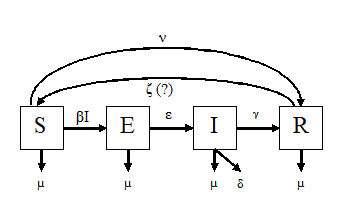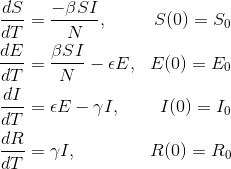Overview:
The SEIR model attempts to predict the flow of a population of size N between four states: susceptible (S), exposed (E), infected (I), and removed (R). Removed individuals are either immune, dead or strictly quarantined. The parameters determine the rates of transition from one state to another: from susceptible to exposed , from exposed to infected, and from infected to removed. This model has two additional parameters; one is the background mortality unaffected by disease-state, μ, while the other is vaccination rate, ν. Vaccination moves people from susceptible (S) to removed (R) directly, without becoming exposed or infected.The SEIR differs from the SIR model in the addition of a latency period. Individuals who are exposed (E) have had contact with an infected person (I), but are not themselves infectious. Infectious individuals can range from completely asymptomatic to critically ill.
Instructions:
The parameters can be entered on the left. The page should load with some parameters already populated.
Click "Start" to run the model. The parameters can all be modified and the model re-run.
Note that due to rounding errors, total population N=S+E+I+R may vary slightly between time intervals.
This is a standalone client-based application that runs directly on your device. Note that cookies must be enabled for the algorithm to function.
| Parameter description | |
|---|---|
| Beta (β) | Mean number of adequate contacts per person per unit time.
An adequate contact is defined as a contact that, if the contacting individual was infectious, would result in an exposure (S → E).
So it is dependent not only upon the "contagiousness" of a pathogen,
but also upon how often a susceptible individual has the opportunity to be near it. This is where social isolation becomes important. |
| Epsilon (ε) | The rate at which an exposed person becomes infective (E → I). 1/ε = mean incubation time before becoming infectious |
| Gamma (γ) | The rate at which an infected recovers (or dies) and moves into the removed phase (I → R). 1/γ = mean infectious time |
| Delta (δ) | Infectious mortality rate ≈ γ • Case fatality rate. Not incorporated into this model. |
| Xi (ξ) | Loss of immunity rate. Not incorporated into this model. |
| R0 | Basic reproduction number.
Mean number of secondary infections produced by one infected individual when they are introduced into a host population where everyone is susceptible.
It is defined only at the onset of the epidemic. This is not the same R0 that denotes the size of R at the onset of an epidemic. Standard but confusing notation. |
| Sigma (σ) | Average number of contacts sufficient for transmission of a typical infective during their infectious period. If mean infectivity does not wane, then σ(t) = R0 for all t. |
| R | Replacement number. Average number of secondary infections produced by a typical infective during their entire period of infectiousness. This is not the same R that denotes the size of R, the Removed compartment. Standard but confusing notation. |
| Mu (μ) | The natural mortality rate (this is unrelated to disease). μ=0 is a population of a constant size in the time frame under consideration |
| Nu (ν) | Vaccination rate during infection cycle. 1/ν = mean time to vaccination of an individual in S. Previously vaccinated and natively immune individuals are in the Removed (R) compartment |
| Initial susceptible (S0) | The number of susceptible individuals at the beginning of the model run. |
| Initial exposed (E0) | The number of exposed individuals at the beginning of the model run. |
| Initial infected (I0) | The number of infected individuals at the beginning of the model run. |
| Initial removed (R0) | The number of recovered individuals at the beginning of the model run. |
| Days | Controls how many days the model will run |
Diagram of Model

Computation Details:
This is an ordinary differential equation model, described by the following system of equations:

This simulation uses a generic Javascript version of the fourth-order Runge-Kutta algorithm with a step size fixed at 0.01 to obtain a numerical solution.
DisclaimerThis application is for illustrative, education and entertainment purposes only. Valid epidemic modeling can be much more complex. Infectious individuals can migrate into a population. The parameters may be time dependent and thus would become variables.
| Beta: | |
| Epsilon: | |
| Gamma: | |
| Mu: | |
| Nu: | |
| Initial | |
|---|---|
| Susceptible: | |
| Exposed: | |
| Infected: | |
| Removed: | |
| Day | |
